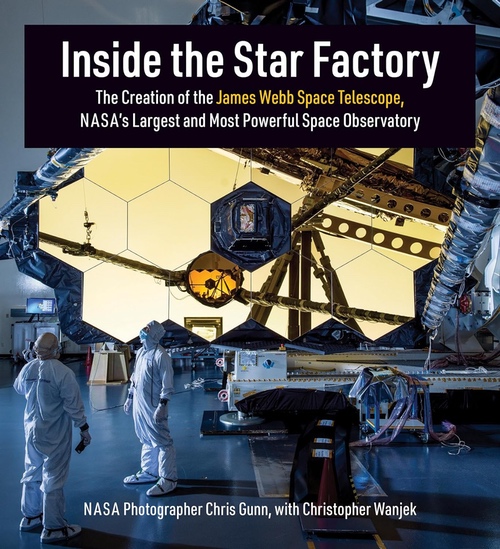Inside the Star Factory: The Creation of the James Webb Space Telescope, NASA’s Largest and Most Powerful Space Observatory by Chris Gunn with Christopher Wanjek MIT Press, 2023 hardcover, 188 pp. , illus. ISBN 978-0-262-04790-6 US$44.
95 For the last year and a half, the James Webb Space Telescope has dazzled scientists and the general public alike with stunning images (see “The transformation of JWST” , The Space Review, July 18, 2022. ) Those images, besides their aesthetic value, have demonstrated the performance of the telescope and its instruments, and their ability to achieve their scientific goals. Ironically, while we are treated to a steady stream of images from JWST, we have effectively no images of JWST during that time.
The last real look at this $10 billion spacecraft came from a camera on the upper stage of the Ariane 5 rocket that launched the telescope on Christmas Day 2021. The only exceptions are “selfies” of the telescopic’s iconic array of hexagonal primary mirror segments taken during the commissioning process, instantly recognizable yet also ghostly, since they do not show any other element of the spacecraft. There are, of course, thousands of images of JWST taken during its lengthy development process.
Many were taken by Chris Gunn, the photographer assigned by NASA to chronicle its development. In the new book Inside the Star Factory , Gunn presents a selection of those images that takes us through its assembly and testing to its launch two years ago. Inside the Star Factory is two books in one.
The first part of the book, by science writer Christopher Wanjek, provides some background about JWST. One chapter offers a history of the telescope’s lengthy development, including the fiscal and technical difficulties it suffered, while another examines the science it was designed to carry out. He also profiles several people involved with JWST, including scientists, engineers, and managers.
The second part of the book features Gunn’s images along with his own captions for them. These images follow JWST’s development for more than a decade (in one from 2010, showing testing of the module that will host the instruments, he writes when shooting it “becoming painfully aware this project had a long way to go. ”) Those images show how the various elements of JWST came together over many years, gradually taking shape into its now-familiar final form.
The images make clear the scale and complexity of JWST and the challenges engineers faced building and testing it. Gunn explains in captions how he accompanied workers into vacuum chambers to document testing and, in one case, was suspended from a lift to look down on the mirrors as they went through testing. One photo is not of JWST itself but a cavernous area below a vacuum chamber at the Johnson Space Center, what Gunn called the “gritty industrial side of space science.
” A couple of the favorite images of the book show technicians inspecting individual mirror segments after they arrived at the Goddard Space Flight Center. The slight curvature of the mirrors distorts the reflections of the bunny-suited technicians as they scan the golden surface looking for any flaws; their reflections make them look wide-eyed, as if they are comprehending the magnitude of their work. “I remember standing in the glow of the gold and realizing that I had never stood next to something so precious,” Gunn writes in the caption of one such photo.
That is, a decade later, the looks on the faces of scientists as they got their first glimpses of the images those mirror segments, and the rest of JWST, could produce. Gunn’s work documenting JWST is now done, but his work documenting space telescopes is not: a recent NASA profile of his work noted he is currently photographing the development of the Nancy Grace Roman Space Telescope. Roman is smaller and less complex (and less expensive) than JWST, but is designed to produce its own remarkable images—and, Gunn, likely, will provide his own remarkable images of Roman.
Jeff Foust ( jeff@thespacereview. com ) is the editor and publisher of The Space Review, and a senior staff writer with SpaceNews . He also operates the Spacetoday.
net web site. Views and opinions expressed in this article are those of the author alone. Note: we are using a new commenting system, which may require you to create a new account.
.
From: thespacereview
URL: https://www.thespacereview.com/article/4714/1



